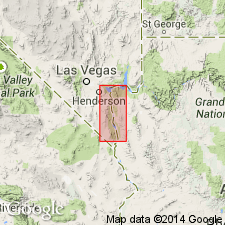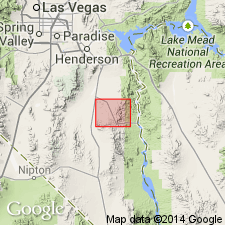
- Usage in publication:
-
- Golden Door volcanics*
- Modifications:
-
- Named
- Dominant lithology:
-
- Rhyolite
- Andesite
- Latite
- Tuff
- AAPG geologic province:
-
- Plateau sedimentary province
- Great Basin province
Summary:
Named for the Golden Door mine, about 3 mi southwest of Mount Perkins, west side of Black Mountains, Mohave Co, AZ in Plateau sedimentary province. Type section is at the mine. Mapped (geologic map) in Black Mountains, Eldorado Mountains, Hoover Dam area on south side of Lake Mead into Clark Co, NV, and in River Mountains of Clark Co in Great Basin province. Consists of lavas, breccias, and tuffs. Is light colored (in contrast to the somber brown of the Patsy Mine volcanics, also newly named). Is at least 5,000 ft thick. Is higher in silica than the older Patsy Mine volcanics and than the younger Mount Davis volcanics (named). High silica lavas vary from rhyolite to andesite. Latite and andesite are more abundant at base, and latite at top at type. Rhyolite breccia and tuff present at Hoover Dam. Section of volcanics locally complicated by intrusive bodies. Local variations in lithology. Tertiary age; shown as Eocene? to Miocene? on geologic map. Shown as Eocene? or Oligocene on a table. Unconformably underlies Muddy Creek formation.
Source: GNU records (USGS DDS-6; Denver GNULEX).

- Usage in publication:
-
- Golden Door Volcanics*†
- Modifications:
-
- Abandoned
Summary:
Term not used in recent mapping. Rocks assigned to Golden Door correlated with the Patsy Mine Volcanics, an older unit. Name Golden Door replaced by the informal term tuff of Bridge Spring.
Source: GNU records (USGS DDS-6; Denver GNULEX).
For more information, please contact Nancy Stamm, Geologic Names Committee Secretary.
Asterisk (*) indicates published by U.S. Geological Survey authors.
"No current usage" (†) implies that a name has been abandoned or has fallen into disuse. Former usage and, if known, replacement name given in parentheses ( ).
Slash (/) indicates name conflicts with nomenclatural guidelines (CSN, 1933; ACSN, 1961, 1970; NACSN, 1983, 2005, 2021). May be explained within brackets ([ ]).

